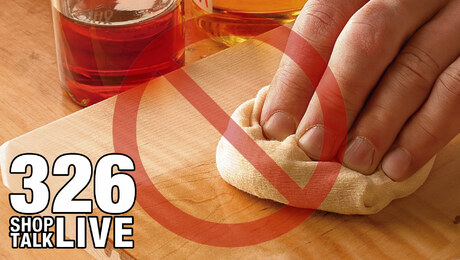STL219: Dadoes without dado blades
Mike, Anissa, and Ben discuss dust collection for bandsaws, keeping notes during a project, a listener's odd glue-line failure, and try a woodworking potpourri for the first time.Question 1:
From Joe:
Dear Ben, Fine Woodworking brain trust,
For the past 4 years, I have been doing hand-tool only woodworking and I don’t own any machine tools. It really floats my boat but thicknessing boards say from ¾” to 3/8” isn’t my idea of a fun Sunday. Lately I’ve just been working with a local company and buying pre-milled S4S in desired thicknesses. I have been thinking of getting a bandsaw for resawing purposes. I worry about dust and my lungs. What sort of specs should I look for in a dust collector if it is only going to be used for a bandsaw?
 |
Better Dust Collection for the Bandsaw |
 |
Smart Dust Collection for Your Bandsaw |
Question 2:
From Scott:
In episode 214.5 the importance of taking notes during a build was touched upon several times. What method do you use for keeping records of each project? Thanks for the many enjoyable hours of info, insights, and humor on your podcasts!
 |
Shop Tour: Christian Becksvoort |
Segment: Segment pot luck!
Anissa: Smooth move- moving the fence in the wrong direction trying to trim a piece for 20 minutes.
Ben: Tool Bomb – Folding ruler
Mike – Wedging pulls from Hida Tools
 |
Make Your Own Hardware |
 |
Make Your Own Snipe Hinges |
 |
Sculpt Your Own Hardware |
Question 3:
From Lukas:
Hello everyone, especially Ben,
I’m designing a wall shelf with the horizontals and verticals overlapping on all sides, similar to a shelf I found on Chris Becksvoorts’s website. Do you happen to know how he does the joint exactly? I can’t make it out from the photo. Obviously it’s some sort of a lap joint, but since it’s so deep, I think there needs to be support for the loose sides of the boards so that they don’t bow. Is he also running a shallow groove to house the loose sides?
I have a tablesaw (no dado blade though, illegal in Europe!) and a router table (plus a planer, drill press and hand tools). And I’m a beginner-ish woodworker, but I’ve done a few projects already and I think I can pull this off.
*note – All of the possible reasons we came up with about the reasoning behind this law is wrong. We’ll publish something soon explaining it all.
Question 4:
Help me Oh-Ben-Strano, STL is my only hope!
I recently encountered a glue line failure on a desktop. I’m trying to understand the cause and repair the piece. It may be a question that only the late R. Bruce Hoadley could answer. The desktop is 40 x 20 from a single 4/4 hard maple board The desk was completed in April 2017 and didn’t present the problem until a couple of months ago, when a gap as large as 0.055 inch opened up over 18 inches of the glue line:
The glue-up went very well at the time. There was plenty of squeeze-out, top and bottom, and the result was a gap free and straight top. The ends of the joint are still very much intact, with no signs of separation. About a year ago, my daughter acquired a gaming laptop which has been used on the desktop since. It looks like the narrower side has shrunk where the gap is, and the wider side has not. The computer can run very hot, leaving me to wonder if that somehow affected the glue? Could I have starved the joint by over clamping?What am I missing? How do I repair this? Should I rip along the glue lines, re-joint and glue, or will I have to do this again in 3 years?
Recommendations:
Ben: Mario Messina on IG – messina designer craftsman
Anissa: Mister Tfue on YouTube
Mike: @upcycledskateart
Every two weeks, a team of Fine Woodworking staffers answers questions from readers on Shop Talk Live, Fine Woodworking‘s biweekly podcast. Send your woodworking questions to [email protected] for consideration in the regular broadcast! Our continued existence relies upon listener support. So if you enjoy the show, be sure to leave us a five-star rating and maybe even a nice comment on our iTunes page.




















Comments
In Europe you do you have dado cutters for the tablesaw. The design is different to the American version, see https://uk.feldershop.com/en/Sawing/Grooving-cutters-and-dado-cutters/Adjustable-groove-cutter-for-saw-unit-RB-HW-oxid.html
I liked the PotLuck'opourri - agree with Mike - nicer to hear three thoughtful answers or tips than trying to fit a segment piece.
I made a 'step-down' adapter out of an old ketchup bottle.
Condiment containers may vary in your country.
This goes to a pool-vacuum hose, which connects to a homemade cyclone collector (paint bucket / yogurt pot / traffic cone mix) which THEN gets pulled by an inexpensive shop vac, which I could in theory run the outlet blast through the wall to get rid of the super-duper fine stuff.
I'm too stubborn to pay for stuff I can make, and it's more satisfying.
For DC fittings, make friends with a person that can 3D print. I have printed dozens of hose adapters for all my shop's dust collection needs. The industry needs to get its act together and come up with some actual standards!
Update: 2 minutes after making this comment Ben mentions 3D printing!
Log in or create an account to post a comment.
Sign up Log in